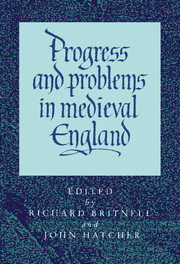Book contents
- Frontmatter
- Contents
- List of figures
- List of maps
- List of tables
- List of contributors
- Edward Miller: an appreciation
- List of abbreviations
- 1 Economic development in the early twelfth century
- 2 Lothian and beyond: the economy of the ‘English empire’ of David I
- 3 Boroughs, markets and trade in northern England, 1000–1216
- 4 Peasant deer poachers in the medieval forest
- 5 The growth of London in the medieval English economy
- 6 The bankruptcy of the Scali of Florence in England, 1326–1328
- 7 The English export trade in cloth in the fourteenth century
- 8 A medieval tax haven: Berwick upon Tweed and the English crown: 1333–1461
- 9 Taxation and communities in late medieval England
- 10 Peasants and the collapse of the manorial economy on some Ramsey Abbey estates
- 11 The famuli in the later Middle Ages
- 12 The great slump of the mid-fifteenth century
- 13 Lorenzo de' Medici's London branch
- 14 The trade of late medieval Chester, 1500–1550
- Bibliography of Edward Miller's published works
5 - The growth of London in the medieval English economy
Published online by Cambridge University Press: 05 June 2012
- Frontmatter
- Contents
- List of figures
- List of maps
- List of tables
- List of contributors
- Edward Miller: an appreciation
- List of abbreviations
- 1 Economic development in the early twelfth century
- 2 Lothian and beyond: the economy of the ‘English empire’ of David I
- 3 Boroughs, markets and trade in northern England, 1000–1216
- 4 Peasant deer poachers in the medieval forest
- 5 The growth of London in the medieval English economy
- 6 The bankruptcy of the Scali of Florence in England, 1326–1328
- 7 The English export trade in cloth in the fourteenth century
- 8 A medieval tax haven: Berwick upon Tweed and the English crown: 1333–1461
- 9 Taxation and communities in late medieval England
- 10 Peasants and the collapse of the manorial economy on some Ramsey Abbey estates
- 11 The famuli in the later Middle Ages
- 12 The great slump of the mid-fifteenth century
- 13 Lorenzo de' Medici's London branch
- 14 The trade of late medieval Chester, 1500–1550
- Bibliography of Edward Miller's published works
Summary
It is widely recognised that the phenomenal growth of London from the late sixteenth century contributed to the development of the modern English economy. But there is less agreement about the extent to which this growth had medieval origins, even though London's share of England's assessed lay wealth grew conspicuously from 2 per cent in 1334 to 8.9 per cent in 1515. Earlier historians explained London's apparent exception to the general picture of urban decline in the fifteenth century by the city's geographical advantages and political status which made its continuing expansion seem inevitable. However, the recent topographical researches of Dr Derek Keene and his colleagues have led them to conclude that, far from being an exception to the general pattern of urban decline, London suffered from the same demographic trends which affected other medieval towns. Most historians have been persuaded by Dr Keene's deductions from the Cheapside evidence that London reached the peak of its medieval population, which he estimates at between 80,000 to 100,000, at about 1300, that it then declined, and that, despite a period of increased commercial activity from the last quarter of the fourteenth century until the 1420s, the city did not recover its former size until about 1600.
Dr Keene accounts for London's growth before 1300 by the two customary explanations that the city grew with the national population, and that its emergence as the centre of government meant that the purchasing power of the royal court moved away from the fairs and was concentrated in London at the end of the thirteenth century.
- Type
- Chapter
- Information
- Progress and Problems in Medieval EnglandEssays in Honour of Edward Miller, pp. 89 - 106Publisher: Cambridge University PressPrint publication year: 1996
- 11
- Cited by

